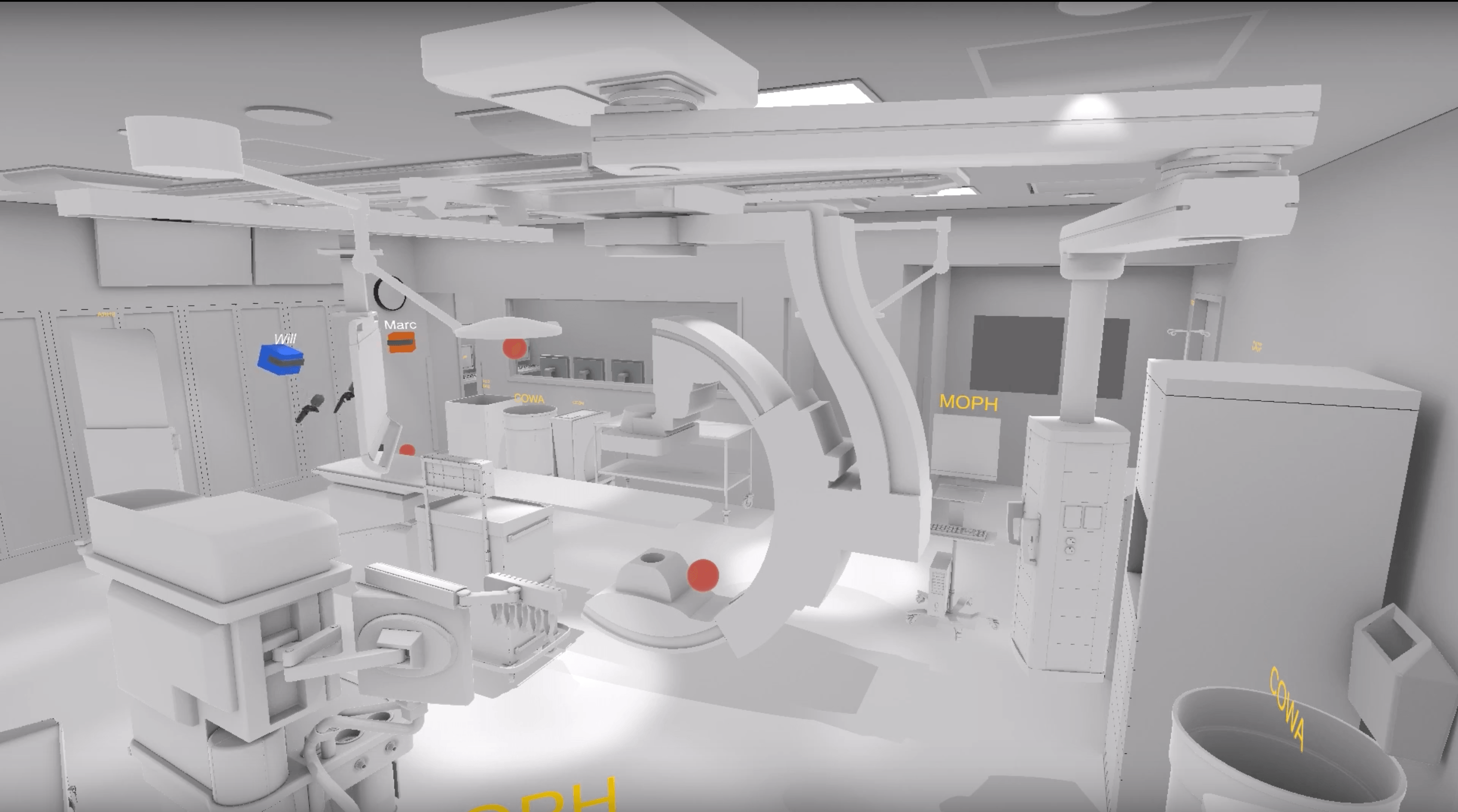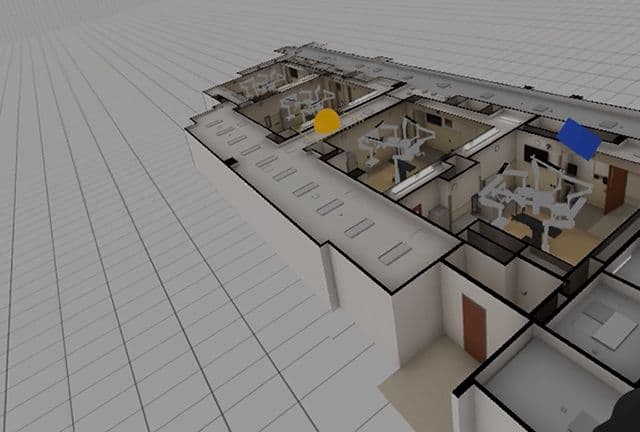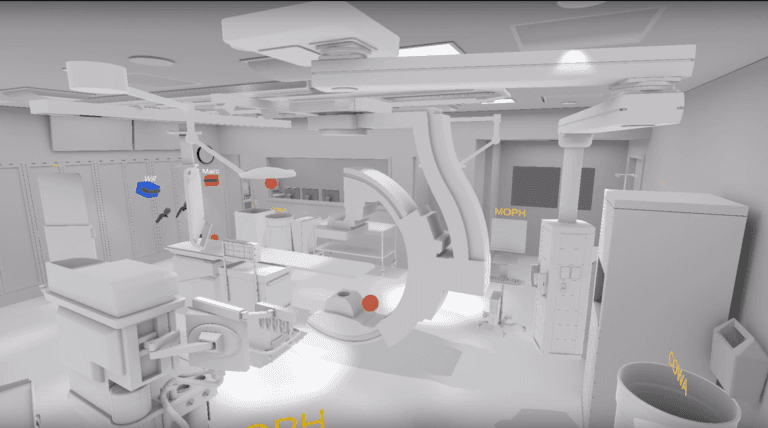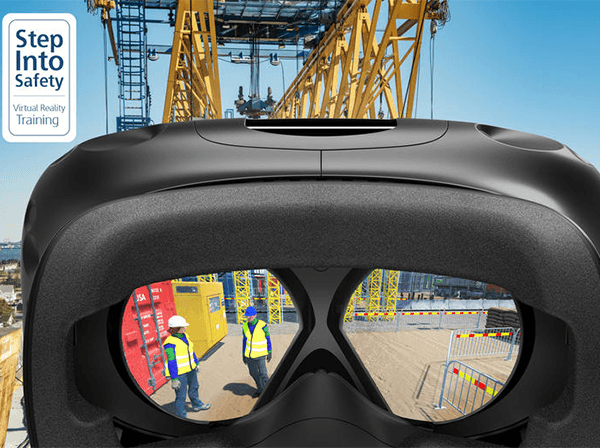
Wie senkt man Kosten und das enorme Risiko bei AEC-Projekten im medizinischen Bereich? Mortenson hat einen Weg gefunden: Durch die perfekte Simulation von neuen Krankenhäusern und Operationssaaldesigns in einer interaktiven 3D-Umgebung können Kunden wichtige medizinische Einrichtungen, Arbeitsbereiche und Technologien umfassend visualisieren und mit ihnen interagieren, um eine optimale Einrichtung und Benutzbarkeit zu gewährleisten. Daraus ergeben sich große Vorteile für eine optimierte Patientenversorgung, effizienterer Belegschaftseinsatz und niedrigere Kosten.
3425Interaktives VR verbessert Krankenhausdesign für Kaiser Permanente und andere
Unterstützen Sie Ihre Kunden dabei, neue Designprojekte zu visualisieren, zu erleben und abzusegnen.
VR: HTC Vive, Oculus Rift, Oculus Go, HoloLens, 360-Grad-Videos
4
Seattle und Minneapolis, USA

Mortenson ist ein US-amerikanisches Unternehmen mit Sitz in Minneapolis, MN, das zu den 20 führenden Anbietern für Bau-, Entwicklungs- und Konstruktionsdienstleistungen für Energie- und Bauprojekte gehört. Das Privatunternehmen mit 5.000 Mitarbeitern und einem Umsatz von 3,8 Mia. $ hat Niederlassungen überall in den USA. Die Expertise des Unternehmens ist extrem gefragt für den Bau kommerzieller Gebäudekomplexe, nachhaltige/umweltfreundliche Bauprojekte, VDC (Virtual Design and Construction), Bausicherheit und vieles mehr.
Bereits vor Jahren erkannte Mortenson den Mehrwert der Integration von Visualisierungstechnologien in seine Design-/Kundenerfahrung und stellte ein Virtual Insights-Team zusammen. Seitdem ist das Unternehmen zu einem Experten in der Verwendung von Unity zur Bereitstellung von interaktiven VR- und 360-Grad-Videoerfahrungen für eine breite Palette von Kundenanforderungen geworden – beispielsweise für die Überprüfung von Gebäudedesigns und Marketinginitiativen.
Seine VR-Krankenhauskunden umfassen das University of Washington Medical Center und Kaiser Permanente.
Die Ergebnisse:
Several years back, Seattle-based Will Adams and Marc Kinsman, Emerging Technologies Developers at Mortenson, saw the value of VR and 360 video for client projects. The first Oculus headset was just out and Adams got in on the ground floor knowing that Unity supported the platform.
“I was working on a design project for the Minnesota Vikings’ stadium. Even though my background is mostly in architecture and design (and some rendering), I was able to convince our project team to explore the idea of simulating the new space with a 3D rendering engine. At the time, I had little experience doing that but I just knew that it would look cool and be easy to output to VR.” Adams’ colleague, Marc Kinsman, was also on board “because Unity has a big supportive community, which meant it would be easy to learn.”
As Adams, Kinsman and colleagues on the Virtual Insights team got up to speed on Unity, their first virtual reality (VR) projects covered the basics of the new 3D space but not much more. “When we started, we were mainly focused on simple virtual projects that clients could walk around in, but over the past few years, we’ve realized how important it is to build interaction into these environments for user engagement.”
When the Virtual Insights team begins a VR project, they use many architecture assets and other resources, which they download from the Asset Store as needed and they also pull in a lot of models from other software such as 3ds Max, SketchUp, and Rhino. Internally, they collaborate a lot, so they are all networked in Unity, which speeds up development and problem-solving, but also means that their customers throughout the U.S. and in Europe can collaborate in real-time in these custom VR spaces.
Due to the wide-ranging client deliverables, the team favors a number of Unity features for their projects, such as the C# API. “We can do pretty much anything we want with the API. It gives us confidence when we’re doing proposals because even if the customer wants something we’ve never done before, we know the API will help us deliver it,” says Adams.
As their projects near the finish line, Kinsman says they like how effortless it is to output to 20-plus platforms. “We’ll jump between Oculus Rift and Oculus Go, the HTC Vive and HoloLens – and we’ve done some stuff for mobile devices too – so using Unity as the base allows us to ‘right fit’ the hardware for the project, and that’s been quite beneficial for us. From the same development platform, we can target whatever’s needed for the project. We don’t have to learn anything new and we can accommodate myriad client hardware and platform requirements.”
When they start a new project, the team typically upgrades to a new Unity version (they’re currently on Unity 2017.3). And as part of their ongoing R&D, they regularly install the latest versions to familiarize themselves with new features they want to try out, such as the Scriptable Render Pipeline (SRP). They’ll be migrating to Unity 2018 soon.

Doing around 20 Unity-based projects a year has given the team a lot of VR and 360 video experience for many top-tier clients, including Kaiser Permanente, the third-largest non-profit hospital organization in the U.S.
“Generally, within the medical arena, clients ask us for help with one major use case: to build a collaborative virtual mockup in 3D space,” says Adams. “Hospital project managers regularly tell us how difficult it is for surgical teams to understand how a procedure room will work for them before it gets built. If the PM can’t get the surgical team to engage and buy in on the project, the hospital inevitably needs to remodel right away because it’s not working for the team.”
For example, Kaiser Permanente was designing a new interventional radiology room and wanted to be sure that it would function smoothly for their medical team. Mortenson built the entire room virtually, according to specifications, so that everyone on the team could enter the space and interact with it in order to help finalize the design of a room they’ll be collaborating in for years. To that end, all the specified equipment was faithfully represented in 3D so the surgical team could reach out and manipulate the light booms, tables, and everything else that they typically interact with. Watch the Kaiser radiology room video to see it in action.
On another project, when Mortenson customers are designing or building a new treatment center or operating room, the client stakeholders – including project managers, doctors, nurses and technical personnel – typically want to interact with the different elements and make decisions about room dimensions, ergonomics, aesthetics, functional systems, and workflow efficiency very early in the project. “It gives them a great opportunity to spot, discuss and correct any problems,” says Kinsman. Watch how Mortenson created a collaborative work environment for the hospital wing of the University of Washington Medical Center.
Im Bereich Designüberprüfungsprojekte für Kunden im Gesundheitssektor liefert das Virtual-Insights-Team von Mortenson ebenfalls signifikante Ergebnisse. Die interaktiven VR-Umgebungen bedeuteten enorme Kosteneinsparungen für ihre Kunden, da große Mängel und nachträgliches Frustrationspotenzial schon lange vor dem ersten Betonguss, der ersten gebauten Mauer und der Bestellung von Materialien behoben werden konnten. Und das alles, ohne Zeit und Geld in den Aufbau einer physischen Nachbildung zu investieren.
Bob Dillon, Großprojektmanager für das University of Washington Medical Center erklärt hierzu: „Die Anlage ist immer da. Man kann einfach wieder reingehen, neue Entscheidungen überprüfen und direkt sehen, wie sich Veränderungen auf den Rest des Projekts auswirken.“ Kinsman fügt hinzu, dass „unsere Kunden stets die virtuelle Nachbildung gegenüber einem physischen Modell bevorzugen, weil es kosteneffizienter und informativer ist.“
Auch von Kaiser erhielt Mortenson sehr positive Rückmeldungen: „Mit Unity konnten wir eine interaktive, detaillierte VR-Umgebung erschaffen, in denen das Team Fehler und Mängel im Entwurf identifizieren, die effizientesten und produktivsten Arbeitsabläufe festlegen konnte und die für den Erfolg des Projekts wichtige Akzeptanz des Fachpersonals steigern konnte. Das erlaubte es Kaiser, den Kostenrahmen und die veranschlagte Bauzeit einzuhalten, ohne vorher viel Zeit und Geld in den Aufbau physischer Nachbildungen investieren zu müssen“, schließt Adams.
Verwunderlich ist es nicht, dass sich Mortenson für Unity als bevorzugte Plattform zur Erstellung großartiger Ergebnisse und Ermöglichung wichtiger designspezifischer Entscheidungen für seine Kunden im Gesundheitssektor entschieden hat: Die Flexibilität von Unity, die umfangreiche Plattform-Unterstützung, das umfassende Ökosystem, die hilfreiche Unity-Gemeinschaft und der Asset Store sind unschlagbare Argumente für Unity.


Das kreative VR- und AR-Studio OutHere arbeitet mit Skanska, dem weltweit fünftgrößten Bauunternehmen, zusammen, um für das schwedische Bauunternehmen realistische Szenarien für dessen Programm „Sicherheit am Arbeitsplatz“ zu entwerfen.

Mortenson, eines der größten Bauunternehmen in den USA, bietet seinen Kunden die Möglichkeit zur Erschaffung, Iteration und Bewertung von Designs in interaktiven 3D-Umgebungen. Erfahren Sie, wie Mortenson die Leistungsfähigkeit von Teams entfesselt und erhebliche Kosten eingespart hat.